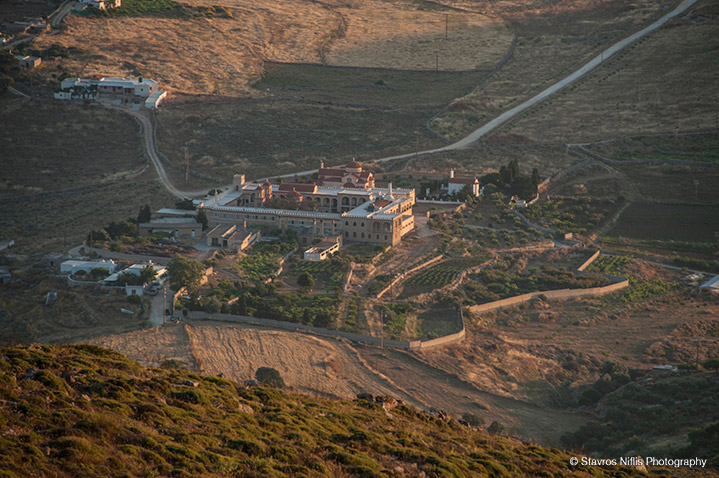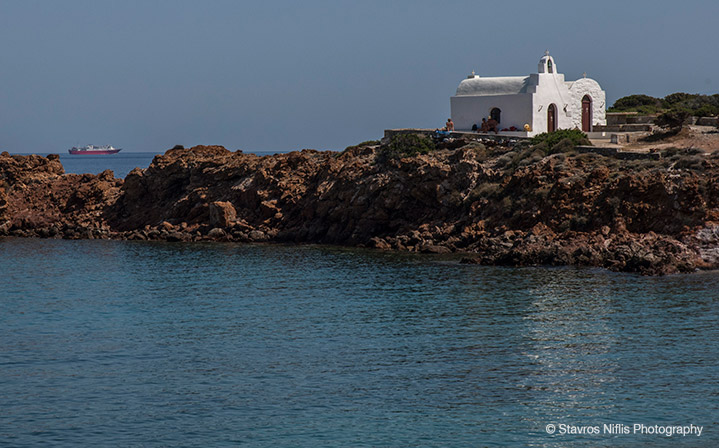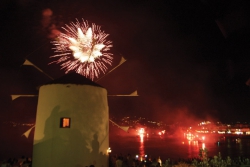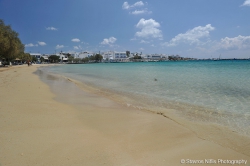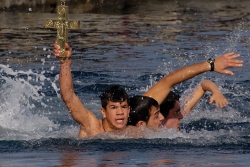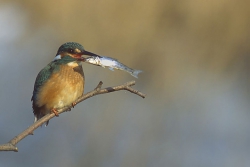Parikia
The Temple of Panagia Ekatontapiliani
According to legend, Agia Eleni encountered a storm off the coast of Paros on her pilgrimage to the Holy Land to find the Holy Cross. She disembarked on the island at a small church. There, she made a vow to Panagia to build a large church in her name if she remained unharmed though the act of God and found the Holy Cross. However, she was unable to fulfill her vow and her son, Constantine the Great, the first emperor of the Byzantine, eventually took up the task.
Panagia Ekatontapiliani is one of the most impressive temples in the Greek islands. The many gaps in the writings of historical sources referring to the exact year in which the church was built have raised debates among scholars. Nonetheless, Panagia Ekatontapiliani is an early Christian cruciform basilica, with many architectural elements added on with the passage of time. The first renovation of the church took place in the 6th century, by an architect named Ignatios, who was, according to legend, a disciple of the master that built Hagia Sophia. The old wooden roof was removed or destroyed by fire and the dome and other arched elements visible today were added.
The temple we see today has many Byzantine and post-Byzantine elements, and marble sections from ancient temples were used in the restorations and additions made through the years. The name Ekatontapiliani refers to the 100 gates of the church - 99 are visible and 1 remains hidden. The secondary name "Katapoliani" may refer to the fact that the church faces the ancient town.
The main church is only one component of the temple, which comprises the inner chapels of Agios Anargyros, Agios Filippos, Osia Theoktisti, the basilica of Agios Nikolaos, the church of Agia Theodosia and the chapel of Agios Dimitrios (outside the church), as well as the Baptistery and surrounding cells that also fortified the church.
The central section, the icon screen, features the holy icon of Panagia of Ekatontapiliani, most likely dating from the 17th century. The marble columns, the remaining marble elements that dominate the space, the small and simple dome with cherubs on its bases, the marble Ciborium that houses the altar and the throne, and the small amphitheater in the back corner are but a few of the elements that draw the eye in the main church.
The Baptistery, built in the 4th century, is one of the best preserved in the Orthodox east and should not be missed.
One of the largest festivals in the Aegean, with traditional music, food and dances is held in Parikia on 15 August, after the procession of the Epitaph of the Virgin Mary.
Agios Konstantinos and Evagelismos tis Theotokou
These two chapels are located side by side in Kastro, atop the ancient acropolis of Paros. They were built on the ruins of an ancient temple and are connected. Agios Konstantinos is a single-aisle church with an octagonal dome and arched bell tower. The interior features sculpted marble and the carved wooden icon screen is gilded. The neighboring Evagelismos tis Theotokou was built in 1260 AD by the Venetian Duke of Naxos and although its interior isn't as ornate as Agios Konstantinos, the ancient elements used to construct it can easily be discerned. The church has a domed roof and lateral narthex supported by columns.
Zoodochou Pigis, on the beach of Kato Yialo
Zoodochou Pigis is a single-aisle vaulted country church, located near the sea, 5 kilometers from Parikia near Marathi, on a steep slope covered in cypress trees. It has been renovated several times, most recently in the early 20th century. An arched bell tower stands above the entrance.
Taxiarchis, on the main market street
The domed church of Taxiarchis is supported by four interior columns. The facade and two marble columns at the entrance attract the attention of visitors. An arch-covered aisle added on to the church at a later date communicates with the main temple and is dedicated to Agia Paraskevi. An arched bell tower stands above the back wall of the church. The church also features many interesting frescoes and icons dating from the 18th and 19th centuries.
Agios Nikolaos, at the port
The church of Agios Nikolas was built opposite the port, near Ekatontapiliani. It is a small cruciform church with an octagonal dome and a small arched bell tower above the main entrance. The tomb of the owner is in an arched recess supported by columns, on the north side of the church, towards the road. The little church has been declared a listed religious monument.
Agia Anna, on the hill of Agia Anna
This small, arched church was built with marble elements from an ancient temple and has an arched bell tower above the door. A column from an ancient temple supports the altar. The church is located in the Kastro, in the Frankish tower.
The Monastery of Agion Anargyron, or Agios Charalampos, looks down on Parikia from the mountain top.
It was initially dedicated to Agios Anargyros, but today the monastery is devoted to Agios Charalampos. The domed, cruciform church was built in 1657. Sections of the monastery were renovated recently, funded by the Temple of Panagia of Ekatontapiliani, to which it belongs.
Monastery of Agios Arsenios (Christos of Dasos) at Petaloudes (Valley of the Butterflies)
The nunnery was built in the 17th century and is located 6 kilometers southwest of Parikia. The church is dedicated to the Metamorphosis of Christ, and the chapel of Agios Arsenios stands in the west courtyard, marking the grave of the Saint. The skull of the Saint is safeguarded in the monastery. Only the abbess and three nuns live at the monastery, keeping it open for the faithful to visit.
Monastery of Zoodochou Pigis, Loggovardas (men only)
Zoodochou Pigis was built in 1638 on the Parikia-Naoussa road and is the most significant monastery on Paros. It was a center of creative activity for important monks, who were engaged in iconography, writing and the arts in general, and houses a valuable library with rare editions and handwritten manuscripts. The cruciform church has one aisle and interesting frescoes.
In the past, the church played a very active philanthropic role. Father Filothoes Zervakos selflessly interceded during the occupation to arrange the release of 125 prisoners from the German camp. At that time, the monastery was inhabited by 30 monks.
Today, it only the abbot and seven monks reside at the monastery, who continue to operate the monastery's winery and ensure its renowned cellar remains stocked. The monastery is the destination for one of the largest pilgrimages in the Aegean. Women are not permitted to enter.
Monastery of Thapsana, Panagia Myrtidiotissa
Southwest of Parikia and northwest of Lefkes, the nunnery at Thapsana dates from 1936. The monastery was built on the ruins of an older monastery at the initiative of Filotheos Zervakos, the abbot of Loggovardas.
The monastery is currently inhabited by 40 nuns engaged in iconography and handiwork. The remains of sainted Father Filotheos are interned in the tomb beside the church of Agios Nektarios, who lived on the island and instructed the Father.
The monastery celebrates the Ypapanti tou Kyriou (2 February), Panagia Myrtodiotissa (24 September) and the anniversary of the death of Father Filotheos (8 May).
Frankish Monastery
The Frankish Monastery is a church located very near Ekatontapiliani, which was founded by Franciscan monks in 1680, on the site of a small chapel dedicated to Archangel Michael.
The church belongs to the Catholic archdiocese of Naxos and Catholic mass is held there every Sunday in summer months.
The single-aisle basilica with an octagonal dome and arched bell tower was originally dedicated to Archangel Michael, but is currently devoted to St. Anthony of Padua. The buildings of the old monastery are now owned by Panagia Ekatontapiliani, and the independent, recently renovated church is in very good condition.








_1.jpg)
.jpg)
